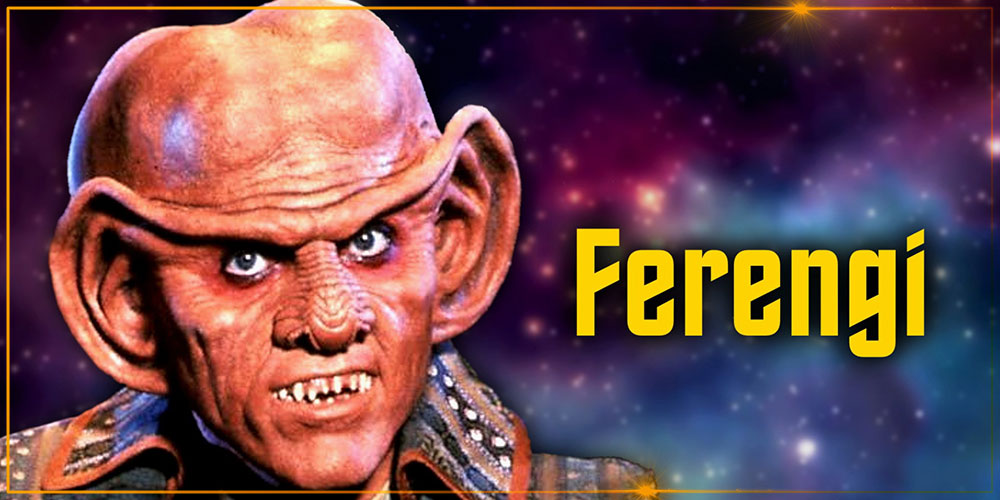Hey guys, Tyler here. In previous videos, I’ve asked you which alien species you want to see me cover on my channel. One of the most popular of these suggestions is the Ferengi. First introduced in Star Trek: The Next Generation and heavily featured in Deep Space Nine, the Ferengi are depicted as greedy hyper-capitalists in contrast to the more socialistic Federation. One of my initial hesitations to covering them earlier on my channel is that I couldn’t quite square what to add to the discourse about this species.
They are, indeed, one of the most fleshed-out species in the Star Trek universe, in some ways more so than, say, the Vulcans or the Klingons. But I realized that in and of itself opened up more opportunities for discussion, as there are a number of characteristics the Ferengi possess that set them apart from other races.
I will be discussing elements of their unique biology and dissect their history and culture to uncover parallels to humanity and other life on Earth. I’ll also examine the history of their appearances throughout episodes of the different Trek series and how they’ve evolved from a comical adversary to a more serious power with a rich cultural background. So, without further ado, let’s jump right in.
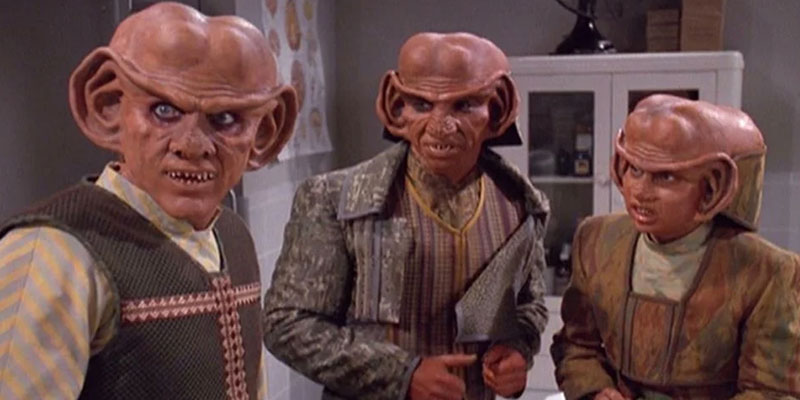
Anatomy
As far as their appearance, Ferengi are shorter than humans on average. Externally, they possess hairless orange-brown skin, blue fingernails and toenails, large heads, wrinkled noses, sharp teeth, and large ears, referred to as “lobes.” These lobes give the Ferengi acute hearing, sensitive enough to discern a person’s gender and species, even through electronic interference and atmospheric distortion, and they can even tell the decibel level of a sound.
Such acute hearing would have given them a distinct advantage in their early evolution to avoid predators and catch prey themselves. Their internal anatomy includes upper and lower lungs as well as a four-lobed brain that is incredibly difficult to read by telepaths and empaths. Notably, the human brain is often categorized into five or six lobes, depending on the definition. And two of these lobes, the cerebrum and cerebellum, are themselves further divided into lobes.
This four-lobed anatomy—which some production sources have also said applies to the Breen and the Dopterians—likely means that various functions are grouped together in a way that is truly alien compared to Earth mammals.
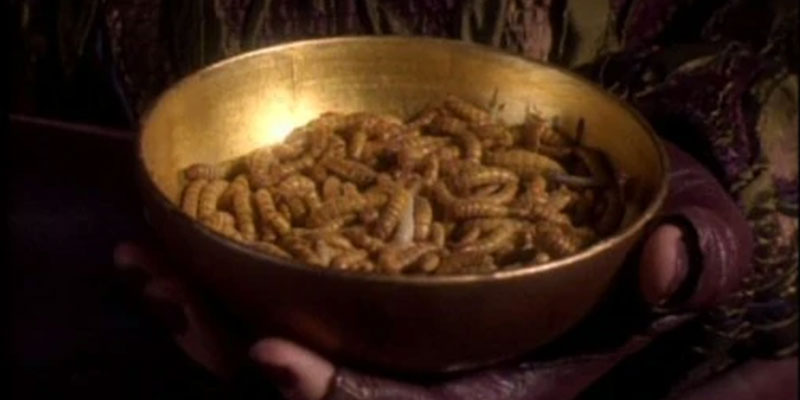
Diet
The Ferengi are also primarily insectivores—their diet mainly consists of bugs, though it also includes other invertebrates like crabs or slugs. Ferengi are notably picky about the kinds of bugs they eat—they often don’t eat bugs from other planets. In Earth taxonomy, insectivores actually used to comprise an entire order of animals but have since been reclassified as not all of them are closely related.
In addition to some other insects, examples of insectivores include various species of birds, frogs, lizards, spiders, and mammals such as anteaters, aardvarks, opossums, and bats. Indeed, early designs for the Ferengi showed them with more batlike ears. Between these traits, as well as their inclination to hiss when threatened, the Ferengi evolutionary lineage may include analogues to various carnivorous mammals such as cats or even small primates like the marmoset. In fact, some research even suggests the earliest primates were nocturnal, arboreal insectivores. Given the swampy conditions of the Ferengi homeworld, it would make sense for their ancestors to make the evolutionary leap from the trees to the ground as they became predators with more complexly developed brains.
Besides their brains, however, the teeth of insectivores, even the mammals, also vary widely from species to species. Some have more pronounced canines, for example, while others have significantly reduced canines, meaning the teeth of individual species have likely evolved for different purposes other than just crunching down on some grubs. It’s also possible that Ferengi has been eating bugs for a relatively short period of their history, having shifted away from a more diverse diet in order to adapt to overpopulation and changing climatic conditions on their homeworld, though this is entirely speculative.
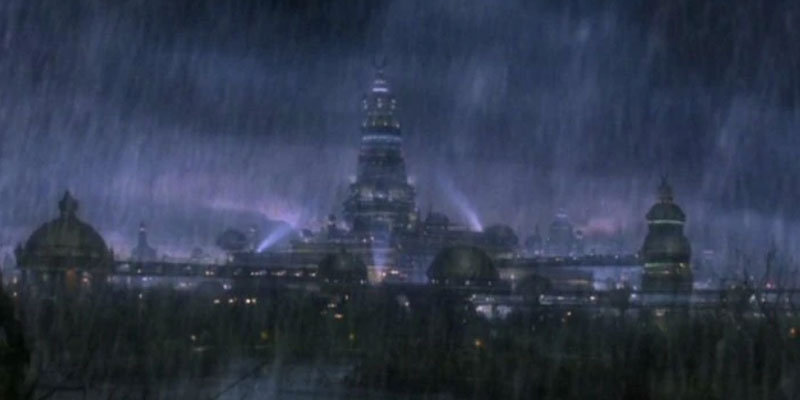
Home System
Speaking of the Ferengi homeworld, it is named Ferenginar, as is their capital city. Like the other homeworlds of many other Star Trek species, it is a Class M planet with Earthlike conditions. As a matter of fact, the writers purposefully decided to give Ferenginar a moist, swampy climate to set it apart from most other Trek environments, which are hot and dry—likely because they’re all filmed on location in the California desert. Ferenginar has nearly constant, planet-wide torrential rains, rotting vegetation, and rivers of muck.
It’s unclear whether these climactic conditions have been present for aeons or whether the increased precipitation is a result of anthropogenic climate change since Ferengi businesses are known to pollute. What is clear, though, is that it’s been around long enough that it’s had a significant impact on Ferengi culture, as they have 178 words for rain, and their architecture heavily incorporates domes and other sloped surfaces to provide for water runoff.
We haven’t seen the star Ferenginar orbits on screen, but non-canon reference materials state it is either an M-type red dwarf star or a K-type orange star. According to real-life science, most planets orbiting red dwarf stars would be tidally locked, meaning one side always faces the star, leaving half the planet in perpetual day and the other half in perpetual night. Alien species evolving on such a world would probably look and behave totally differently from the life we’re familiar with due to the planet’s unique ecosystems.
Though there are some M-class planets with humanoid civilizations in Star Trek that orbit red dwarfs, many more featured on-screen orbit red giants, but Star Trek: Star Charts and Stellar Cartography do not depict Ferenginar’s primary as being particularly large. Thus, I’m more inclined to believe that Ferenginar orbits a K-type orange star, not unlike the Vulcan sun. These types of stars are among the most stable in the universe and the second longest-lived, creating a relatively calm stellar radiation environment for life to evolve on planets with strong magnetic fields.
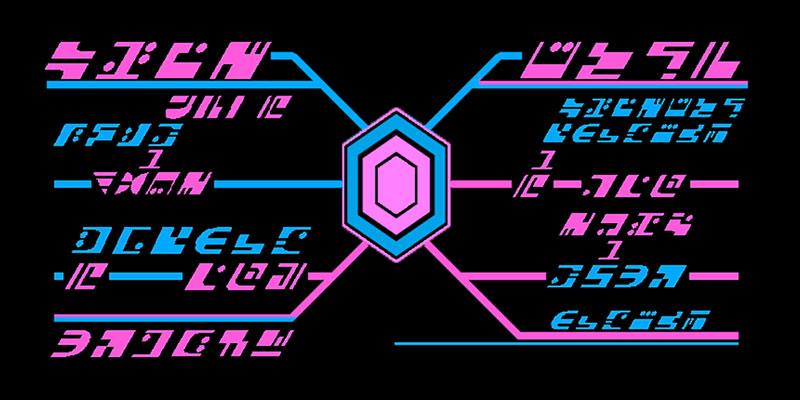
Language
Ferengi language is particularly interesting from a human perspective. Their main alphabet consists of over sixty phonetic symbols, almost as long as the Khmer alphabet with 74 letters. The Ferengi language is written like a flowchart, with text radiating at sixty-degree angles from a central hexagon denoting subject or tense. We occasionally see Ferengi text written left to right as well. Between this and the different sounding spoken languages in their appearances in various episodes, it’s safe to assume that there are multiple Ferengi dialects, and speakers of these dialects all conduct business throughout the galaxy.
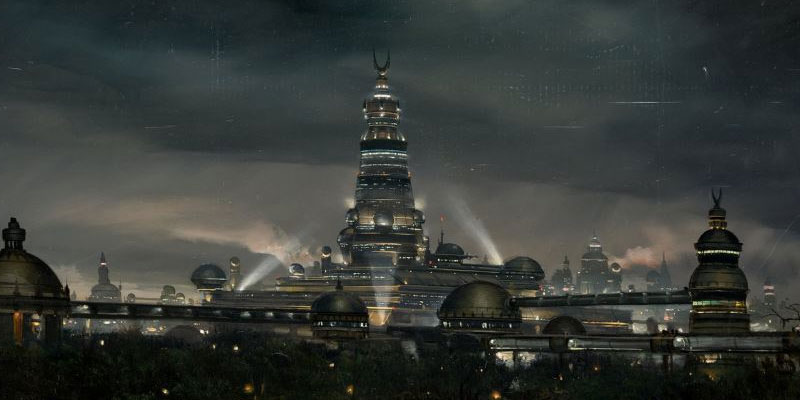
History & Culture
Recorded Ferengi history as far as we’re aware goes back at least ten thousand years. Around this time, the concepts of currency and profit were first invented in Ferengi culture. Fundamental precepts of Ferengi society, such as greed and materialism, were first enshrined in the Rules of Acquisition, authored by the first Grand Nagus, Gint. The Ferengi developed many features of a modern economy long before humans, such as banking, speculative investments, and by 2700 BC, a unified global economy. Early Ferengi was apparently less greedy and more generous than their modern descendants, indicating a slow but steady acceptance of the Rules of Acquisition into every facet of Ferengi society. Despite their longtime practice of capitalism, the Ferengi avoided atrocities like slavery, genocide, concentration camps, and interstellar wars.
This less violent approach to building their civilization may be one reason they took nearly five thousand years to acquire warp drive after achieving globalization, owing to a slower rate of industrialization. In any case, though, their definition of slavery evidently did not extend to their treatment of women, and Ferengi has been shown willing to engage in the trading of alien slaves if profitable. Violence is also not completely absent from their society as they still practice capital punishment. But for the most part, as Quark and others will proudly boast, day-to-day life on Ferenginar is relatively peaceful…except, as we see, this is not a positive peace, but a negative peace.
Overall, Ferengi society is depicted as still being far from liberal in the 24th century, as they are extremely patriarchal and misogynistic. Before progressive reforms under Grand Nagus Zek and later Grand Nagus Rom, women were barred from legally earning a profit, being able to travel, wear clothes, express opinions or political views, or inherit property. Marriages were business contracts signed between the groom and the bride’s father, with the bride treated as property that was leased from one family to another.
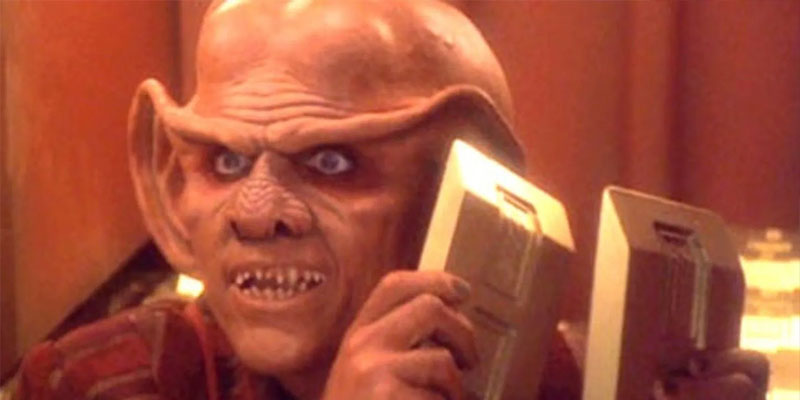
It is only in the third quarter of the 24th century that some semblance of gender equality under the law begins to be embraced, as Ferengi realize that, well, enfranchising half the population would actually be good for business. In this way, the initial reforms instituted by Zek and Rom—including taxes to fund social programs like welfare, retirement benefits, and healthcare—are intended to preserve Ferengi capitalism, but further influence from the moneyless Federation puts the Ferengi on track to become a more equitable society. Other developments in this vein include shifting beliefs among observers of the Ferengi religion, traditionally centred on earning material wealth to be rewarded in the afterlife. After the Dominion War, 40% of Ferengi no longer believed they needed to buy their way into the “Divine Treasury.”
The Ferengi Alliance—the formal name of the Ferengi government—is located in the Alpha Quadrant, with the Alliance’s seat of power on Ferenginar located about 60 light-years from Bajor. The Alliance is dedicated to promoting Ferengi profit and commerce. As businessmen have served as pillars of Ferengi society for millennia, this has led to a slow merging of the business and political fields, with the Ferengi Commerce Authority enforcing trade bylaws on behalf of the Alliance. The Ferengi territory covers a relatively small region of space, with just shy of a dozen key systems located close to their homeworld, but Ferengi business and trade ventures have led to them having a much more ubiquitous presence throughout local space. In fact, this could be why they have such a low Borg species designation—Species 180—perhaps members of the species accidentally visited the Delta Quadrant through a wormhole or perhaps via the mycelial network, or the Borg encountered them early on in the Alpha Quadrant through a transwarp hub.
Speaking of warp, it’s also stated in various background sources that the Ferengi purchased warp drive from the Breen, and this transaction occurred around the early-to-mid-21st century. Indeed, in the episode “Little Green Men,” Quark indicates the Ferengi lacked warp drive before at least the mid-20th century. Apparently, unlike Zefram Cochrane, the Ferengi did not view it as profitable to develop warp drive on their own. The Ferengi are also said to be related to the Dopterians, who themselves possess a resemblance to the Cardassian-aligned Kobheerians. This could indicate some speciation of various Ferengi space travellers after their acquisition of warp drive, though just as with many other examples of evolution in Star Trek, the timeframe of Ferengi interstellar expansion is not long enough for natural evolution to occur. Thus, the Dopterians could have genetically engineered themselves or been a separate species exiled from the original homeworld, though the latter seems unlikely. Ultimately, I think another likely explanation—perhaps the simplest one—is that by characterizing the Dopterians as “distant relatives” of the Ferengi, the implication is that they just share similar biological characteristics and happened to inhabit the same region of space.
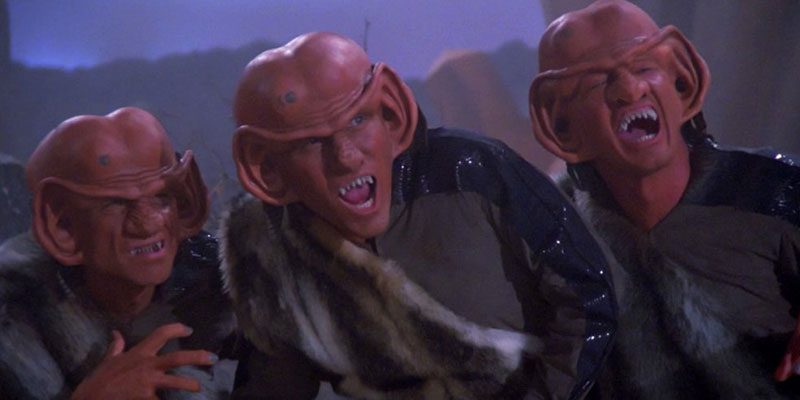
The Ferengi are generally neutral in interstellar affairs, lacking a standing military. But early on, the Ferengi were intended to be a recurring antagonist in The Next Generation, just as the Klingons had been in The Original Series. However, this…didn’t go over very well. Their first appearance in the season 1 episode “The Last Outpost” has been widely regarded as a disaster, with the Ferengi coming across as not as menacing as Gene Roddenberry had originally envisioned. Roddenberry created the Ferengi as analogues to the Wall Street financiers of the 1980s. The name “Ferengi” was derived from the Arabic and Persian word faranji, meaning “frank” as in the Frankish or European traders who made contact with the Arab world. Faranji later came to mean “foreigner,” and specifically in modern Arabic, it means “European.” Roddenberry was very explicit about various aspects of their culture, describing, for example, their various sex positions in excruciating detail to TNG writer Herb Wright. Yes, this happened. As you can imagine, these kinds of details didn’t make it into the final draft of “The Last Outpost.”
After the failure of their initial appearance, the Ferengi were no longer planned as recurring antagonists for the Enterprise-D, though they did appear in a few more episodes. By the time Deep Space Nine was being developed, the Ferengi were in a position to be taken more seriously as a species with complex cultural practices. They effectively emerged as analogues for 20th-century humans, possessing many of the same inclinations toward greed and materialism that our species still exhibits, as opposed to the future humans of Star Trek who have moved beyond greed and materialism. While Ferengi-centric episodes of DS9 still earned a mixed reception from viewers, many of the writers on the show have spoken about how proud they are of how the species ultimately turned out, coming a long way from their one-dimensional debut.
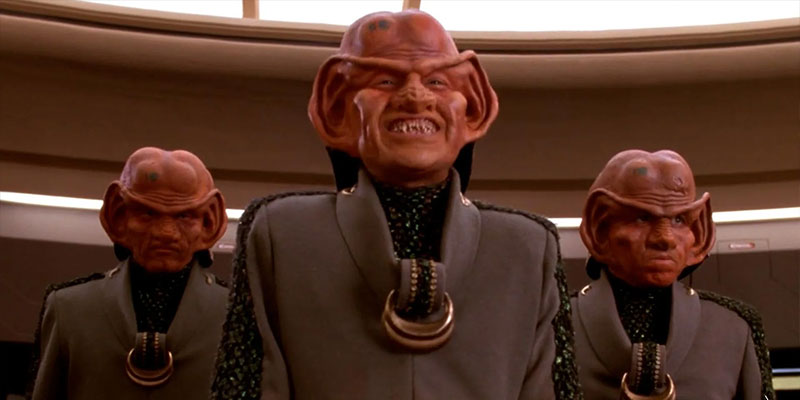
Final Thoughts
There’s so much more to the Ferengi than can easily fit into a video like this. With over 90 appearances across the different series, in addition to Quark’s regular appearance on DS9, it’s no wonder they’re one of the most fleshed-out species in the franchise. Their Alliance’s ubiquity throughout local space will presumably only continue to grow in the coming centuries of Star Trek lore, as we see they’re still very active in the 32nd century. It will be interesting to see how their civilization evolves and they tackle various social ills on their homeworld and respond to outside pressures throughout the galaxy.
As many have noted, it would probably take generations for Ferengi women to fully integrate into the workforce as they unlearn the cultural expectations of their longtime second-class citizenship. And it could take just as long to find lasting solutions to other problems such as poverty, corruption, and more. But I do think, ultimately, that further exploring the Ferengi in future instalments will offer more opportunities to tell stories that reflect our current attitudes towards various aspects of their culture.
Watch The Latest Video By Orange River Media Below
Thanks for watching! I’m interested to hear your thoughts in the comments. If you haven’t yet subscribed, be sure to do that as well so you won’t miss future uploads and click the bell icon to receive all notifications. If you want to support my work even further, becoming a patron at patreon.com/orangeriver is a great way to do so.
I’ll see you in the next video…live long and prosper.
You can find Orange River Media at the links below
- YouTube: https://www.youtube.com/orangeriver
- Twitter: https://www.twitter.com/orangerivernw
- Instagram: https://www.instagram.com/orangeriver.nw
- Facebook: https://www.facebook.com/orangerivernw
- Patreon: https://www.patreon.com/orangeriver

